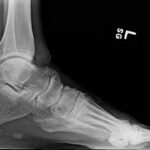Experts discuss high-intensity interval training as an underused “disease-modifying drug” for inflammatory diseases. Learn how to safely integrate it into patient treatment plans.


Experts discuss high-intensity interval training as an underused “disease-modifying drug” for inflammatory diseases. Learn how to safely integrate it into patient treatment plans.

Yvonne M. Golightly, PT, MS, PhD, Jill Halstead, BSc, MSc, PhD, MRCPod, John B. Arnold, PhD, Lara S. Chapman, MSc, BPod, Catherine J. Bowen, PhD, BPod, Marian T. Hannan, DSc, MPH, Hylton B. Menz, PhD, BPod, Kade L. Paterson, PhD, BPod, BAppSci(Hons) & Martin J. Thomas, PhD, MCSP |
Midfoot OA experts offer an overview of a common, but under-recognized, form of OA, & discuss quality of life impacts, treatments, clinical evaluation procedures & the critical need for further research.

Bryn Nelson, PhD |
A recent Proceedings of the National Academy of Sciences study found that high-intensity aerobic exercise may reduce the release of cell-free DNA & tamp down inflammation over time.

This year’s Rheumatic Disease Awareness Month encourages rheumatology professionals to collaborate with patients on physical activity routines that benefit their health.

Risk of Mortality from SLE By Ansaam Daoud, MD, Loai Dweik, MD, & Omer Pamuk, MD Why was this study done? Systemic lupus erythematosus (SLE) is a chronic autoimmune disease with significant mortality, particularly affecting racial and ethnic minorities. This study aimed to assess national SLE mortality trends over the past two decades, stratified by…

Yvonne M. van der Kraan, BSc, Andrew Lui, PT, DPT, Anneke Spoorenberg, MD, Suzanne Arends, PhD, & Lianne S. Gensler, MD |
‘Physical therapy is a mainstay of managing rheumatic diseases, but what’s the evidence, how do we monitor, and what types of therapy should we advocate?’ asks Physician Editor Bharat Kumar, MD, MME, FACP, FAAAAI, RhMSUS. ‘Here, we provide some practical recommendations for the everyday rheumatologist.’ Physical activity, including occupational and recreational activities, is one of…
Experts offered perspectives on how symptoms of rheumatic disease, such as fatigue, affect the physical, cognitive and emotional health of patients and offered solutions.

Yvonne Golightly, PT, MS, PhD, & Aileen Ledingham, PT, MA, PhD |
Some patients avoid using canes due to stigma, but cane use can prevent loss of mobility and increase independence for many.

Magdalena “Maggie” Cadet, MD, a rheumatologist in New York City, remembers learning about the relationship between physical activity and bone health at a young age. She was 5 years old when she first began taking ballet, jazz and tap-dancing lessons. At 9, she became a competitive figure skater and practiced both dance and ice skating…

Lifestyle medicine interventions, such as dietary changes, movement and mindfulness, in combination with conventional treatment, may help alleviate symptoms of rheumatic disease, according to panelists at ACR Convergence 2023.